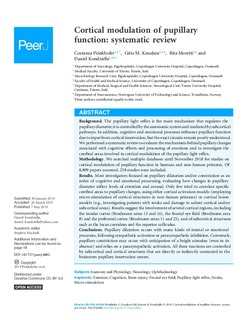| dc.contributor.author | Peinkhofer, Costanza | |
| dc.contributor.author | Knudsen, Gitte M | |
| dc.contributor.author | Moretti, Rita | |
| dc.contributor.author | Kondziella, Daniel | |
| dc.date.accessioned | 2019-10-01T06:19:37Z | |
| dc.date.available | 2019-10-01T06:19:37Z | |
| dc.date.created | 2019-07-04T12:59:47Z | |
| dc.date.issued | 2019 | |
| dc.identifier.citation | PeerJ Brain and Cognition. 2019, 7:e6882 | nb_NO |
| dc.identifier.issn | 2376-5992 | |
| dc.identifier.uri | http://hdl.handle.net/11250/2619462 | |
| dc.description.abstract | Background
The pupillary light reflex is the main mechanism that regulates the pupillary diameter; it is controlled by the autonomic system and mediated by subcortical pathways. In addition, cognitive and emotional processes influence pupillary function due to input from cortical innervation, but the exact circuits remain poorly understood. We performed a systematic review to evaluate the mechanisms behind pupillary changes associated with cognitive efforts and processing of emotions and to investigate the cerebral areas involved in cortical modulation of the pupillary light reflex.
Methodology
We searched multiple databases until November 2018 for studies on cortical modulation of pupillary function in humans and non-human primates. Of 8,809 papers screened, 258 studies were included.
Results
Most investigators focused on pupillary dilatation and/or constriction as an index of cognitive and emotional processing, evaluating how changes in pupillary diameter reflect levels of attention and arousal. Only few tried to correlate specific cerebral areas to pupillary changes, using either cortical activation models (employing micro-stimulation of cortical structures in non-human primates) or cortical lesion models (e.g., investigating patients with stroke and damage to salient cortical and/or subcortical areas). Results suggest the involvement of several cortical regions, including the insular cortex (Brodmann areas 13 and 16), the frontal eye field (Brodmann area 8) and the prefrontal cortex (Brodmann areas 11 and 25), and of subcortical structures such as the locus coeruleus and the superior colliculus.
Conclusions
Pupillary dilatation occurs with many kinds of mental or emotional processes, following sympathetic activation or parasympathetic inhibition. Conversely, pupillary constriction may occur with anticipation of a bright stimulus (even in its absence) and relies on a parasympathetic activation. All these reactions are controlled by subcortical and cortical structures that are directly or indirectly connected to the brainstem pupillary innervation system. | nb_NO |
| dc.language.iso | eng | nb_NO |
| dc.publisher | PeerJ | nb_NO |
| dc.rights | Navngivelse 4.0 Internasjonal | * |
| dc.rights.uri | http://creativecommons.org/licenses/by/4.0/deed.no | * |
| dc.title | Cortical modulation of pupillary function: systematic review | nb_NO |
| dc.type | Journal article | nb_NO |
| dc.type | Peer reviewed | nb_NO |
| dc.description.version | publishedVersion | nb_NO |
| dc.source.volume | 2019 | nb_NO |
| dc.source.journal | PeerJ Brain and Cognition | nb_NO |
| dc.source.issue | 7 | nb_NO |
| dc.identifier.doi | 10.7717/peerj.6882 | |
| dc.identifier.cristin | 1710109 | |
| dc.description.localcode | © 2019 Peinkhofer et al. Licence This is an open access article distributed under the terms of the Creative Commons Attribution License, which permits unrestricted use, distribution, reproduction and adaptation in any medium and for any purpose provided that it is properly attributed. For attribution, the original author(s), title, publication source (PeerJ) and either DOI or URL of the article must be cited. | nb_NO |
| cristin.unitcode | 194,65,35,0 | |
| cristin.unitname | Institutt for psykisk helse | |
| cristin.ispublished | true | |
| cristin.fulltext | original | |
| cristin.qualitycode | 1 | |

